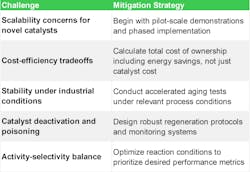Energy Saver: How Catalysts Can Transform Process Industry Efficiency
Chemical Processing's Cliff's Notes
- Catalysts drive industrial energy efficiency, with advancements potentially reducing energy use in key chemical processes by up to 40% by 2050.
- Breakthrough catalytic innovations, such as electrocatalytic enhancement and single-atom catalysts, are revolutionizing reaction efficiency and CO₂ conversion.
- Strategic catalyst implementation through process upgrades, hybrid technologies, and AI-driven optimization is key to maximizing energy savings in chemical manufacturing.
Today, every kilowatt saved translates directly to bottom-line impact. Chemical manufacturing currently consumes about 10% of global energy resources and generates 7% of worldwide greenhouse gas emissions — with just 18 high-volume products responsible for 80% of this massive energy footprint (IEA et al., 2022). But across production facilities worldwide, a microscopic force is silently rewriting the rules of industrial thermodynamics: the catalyst.
Catalysts represent perhaps our most powerful tool for industrial energy efficiency. By lowering activation energy barriers, catalysts enable reactions to proceed at milder conditions, dramatically reducing energy requirements while often improving yield and selectivity.
The impact potential is hard to believe. According to a comprehensive technology roadmap developed by the International Energy Agency (IEA), catalytic improvements could reduce energy intensity for key chemical processes 20%-40% by 2050, translating to approximately 13 exajoules of energy savings annually — equivalent to the entire energy consumption of Germany (IEA et al., 2022).
Research Breakthroughs
Several recent innovations highlight the transformative potential of advanced catalytic technologies:
Electrocatalytic Enhancement
Researchers have recently demonstrated a groundbreaking approach that uses small electrical voltages to enhance conventional acid-catalyzed reactions. This technique achieved efficiency improvements of up to 100,000-fold without requiring redox activity, representing a potential paradigm shift for petrochemical processing (Westendorff, 2024).
Single-Atom Catalysts
Single-atom catalysts maximize metal atom utilization by dispersing individual metal atoms on support materials. This approach not only reduces material costs but significantly enhances catalytic performance in energy-critical applications. For hydrogen evolution reactions — essential for clean energy production — single-atom Pt catalysts have demonstrated activity up to 37 times higher than conventional platinum catalysts (Cheng et. Al, 2016, Ding et al., 2019, Zhang et al. 2022).
Bimetallic Engineering for CO₂ Conversion
Copper-gallium bimetallic catalysts have achieved breakthrough performance in CO₂ reduction, reaching over 50% cathodic energy efficiency at high current densities. These advances make electrochemical carbon utilization increasingly viable at industrial scales (Chen et al., 2024). However, challenges remain to validate long-term durability and material costs of Ga doping.
Real-World Applications
The significance of catalytic advances extends far beyond laboratory settings, as evidenced by several industrial success stories:
Hydrodesulfurization: The Silent Success Story
Modern NiMo-based catalysts have revolutionized hydrodesulfurization for ultra-low sulfur diesel production. Over decades, these catalysts have enabled refineries to reduce diesel sulfur from 2,000 ppm to less than 10 ppm while minimizing energy penalties. For a typical refinery producing 5 million tons of diesel annually, advanced catalysts save approximately 225,000 tons of hydrogen valued at roughly $450 million (Meryt Chemical, 2024).
Green Hydrogen Production
The water-splitting process for hydrogen production has historically been constrained by high overpotential requirements and sluggish reaction kinetics. Recent catalyst developments have dramatically reduced these barriers, with earth-abundant catalysts increasingly matching the performance of precious metal alternatives at a fraction of the cost (Wang et al., 2022). Thermochemical water splitting requires overcoming a 1.23V thermodynamic barrier, but practical systems historically need 1.48 V due to overpotentials (activation, ohmic, and concentration losses). The oxygen evolution reaction (OER), the kinetic bottleneck, has traditionally relied on iridium due to its stability in acidic conditions.
Key Implementation Strategies for Process Engineers
For chemical process engineers seeking to leverage catalytic solutions for energy efficiency, several implementation pathways offer particular promise:
1. Incremental Enhancement of Existing Processes
- Evaluate catalyst replacement cycles as opportunities for efficiency upgrades
- Prioritize drop-in catalytic solutions requiring minimal process modifications
2. Process Intensification Through Novel Catalytic Approaches
- Consider reactor redesigns that maximize catalyst-reactant contact
- Explore multifunctional catalysts that combine sequential reaction steps
3. Hybridization of Catalytic Technologies
- Investigate combined thermal-photocatalytic or electrocatalytic approaches
- Leverage synergies between different catalyst types in integrated systems
4. Digital Optimization of Catalyst Performance
- Implement advanced process monitoring for real-time catalyst efficiency tracking
- Apply advanced (i.e. machine learning or similar) algorithms to predict catalyst deactivation and optimize replacement timing
Emerging Trends and Opportunities
Several promising research directions are poised to deliver the next generation of energy-saving catalytic technologies:
- Earth-abundant catalyst formulations replacing precious metals without performance compromises
- Integration with renewable energy inputs for truly sustainable catalytic systems
- Self-regenerating catalysts with extended lifetime performance
- Multifunctional catalytic materials simplifying complex reaction sequences
- Biomimetic approaches inspired by natural enzymes for unprecedented efficiency and selectivity
Process engineers should stay particularly attentive to developments in computational catalyst discovery. Machine learning frameworks like CatBERTa can now predict catalyst performance using only textual inputs, dramatically accelerating discovery timelines (Catalysis, 2023).
Catalytic technologies offer perhaps our most promising pathway forward in the chemical arts — enabling dramatic energy savings while maintaining or enhancing process productivity.
For process engineers and industry leaders, the message is clear: Catalysts represent not merely an incremental improvement opportunity but a strategic imperative. The evidence spans from laboratory breakthroughs to industrial-scale implementations, with potential impacts measured in exajoules and gigatons. The technologies exist; the challenge now lies in accelerating their implementation across the chemical enterprise.
References
Chen, L., Chen, J., Fu, W., Chen, J., Wang, D., Xiao, Y., ... & Wang, L. (2024). Energy-efficient CO (2) conversion to multicarbon products at high rates on CuGa bimetallic catalyst. Nature Communications, 15(1), 7053.
Cheng, N., Stambula, S., Wang, D., Banis, M. N., Liu, J., Riese, A., ... & Sun, X. (2016). Platinum single-atom and cluster catalysis of the hydrogen evolution reaction. Nature Communications, 7(1), 13638.
Ding, S., Hülsey, M. J., Pérez-Ramírez, J., & Yan, N. (2019). Transforming energy with single-atom catalysts. Joule, 3(12), 2897-2929.
IEA (International Energy Agency), International Council of Chemical Associations, & DECHEMA. (2022). Technology roadmap: Energy and GHG reductions in the chemical industry via catalytic processes. https://iea.blob.core.windows.net/assets/d0f7ff3a-0612-422d-ad7d-a682091cb500/TechnologyRoadmapEnergyandGHGReductionsintheChemicalIndustryviaCatalyticProcesses.pdf
Meryt Chemical. (2024). How advances in catalysts over the years have maximized industrial benefits. https://www.meryt-chemical.com/how-advances-in-catalysts-over-the-years-have-maximized-industrial-benefits/
Westendorff, K. S., Hülsey, M. J., Wesley, T. S., Román-Leshkov, Y., & Surendranath, Y. (2024). Electrically driven proton transfer promotes Brønsted acid catalysis by orders of magnitude. Science, 383(6684), 757-763.
Wang, Y., Tian, Y., Pan, S. Y., & Snyder, S. W. (2022). Catalytic processes to accelerate decarbonization in a net‐zero carbon world. ChemSusChem, 15(24), e202201290.
Zhang, T., Jin, J., Chen, J., Fang, Y., Han, X., Chen, J., ... & Wang, L. (2022). Pinpointing the axial ligand effect on platinum single-atom-catalyst towards efficient alkaline hydrogen evolution reaction. Nature Communications, 13(1), 6875.
About the Author
Thomas Kwan
Global Vice President, Strategic Innovation and Industrial Ecosystems
Thomas Alan Kwan is an energy transition expert at Schneider Electric's Sustainability Research Institute. With a Ph.D. in chemical and environmental engineering, he brings a blend of academic rigor and industrial experience to the field of sustainable manufacturing and green engineering.
At Schneider Electric, he leads initiatives focused on new and emerging industrial systems, with a particular emphasis on the chemical processing sector. His work involves developing innovative solutions and practices to drive energy, environmental and economic benefits.
Previously, he was a key member of Unilever's product engineering team, where he integrated green chemistry and engineering principles for product and process development. His contributions earned him a lifetime honorary membership on the team. Kwan also has experience in environmental regulation, having worked with the U.S. EPA on Clean Water Act programs.
Through his research and collaborations, Kwan continues to explore innovative ways to reduce energy consumption, minimize waste, maximize value and improve overall process efficiency in chemical manufacturing operations.




